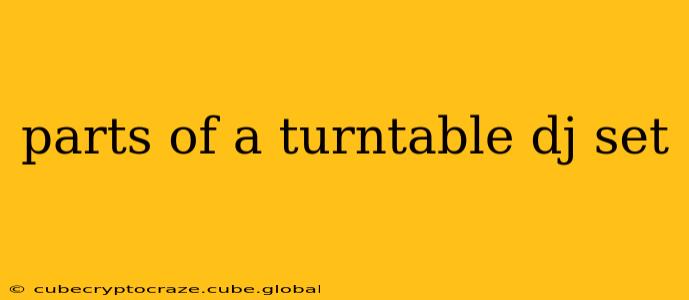For aspiring and seasoned DJs alike, understanding the components of a turntable DJ setup is crucial for delivering a smooth, engaging performance. More than just two turntables and a mixer, a professional setup involves a carefully selected collection of gear designed to enhance creativity and control. This guide breaks down the essential parts, exploring their functions and how they contribute to the overall listening experience.
What are the main parts of a DJ turntable setup?
The core components of a typical DJ turntable setup include:
-
Two (or more) Turntables: The heart of the system, turntables allow DJs to manipulate vinyl records, controlling speed and pitch for seamless transitions and creative mixing. Direct-drive turntables are generally preferred for their superior torque and stability.
-
DJ Mixer: This is the central hub, allowing DJs to blend audio from multiple sources (turntables, CDJs, computers). Key features include crossfader control for smooth transitions, EQs to shape the sound of individual tracks, and various input/output options for expansion.
-
Headphones: Essential for cueing up the next track, monitoring the mix, and ensuring seamless transitions without audible glitches. High-quality headphones are vital for accurate monitoring and extended use.
-
Audio Interface (Often Integrated): Many mixers now incorporate audio interfaces, handling the conversion of analog signals from the turntables to digital signals for recording or broadcasting.
-
Speakers: These deliver the final mix to the audience. The choice of speakers depends heavily on the venue and the desired sound. Active speakers (with built-in amplification) are often favoured for their simplicity.
What accessories are needed for a DJ turntable setup?
Beyond the core components, several accessories significantly enhance the DJ experience:
-
Slipmats: Placed on the turntable platter, slipmats reduce friction, allowing for techniques like scratching without damaging the vinyl. They also improve the feel and responsiveness of the turntable.
-
Slipmats: Placed on the turntable platter, slipmats reduce friction, allowing for techniques like scratching without damaging the vinyl. They also improve the feel and responsiveness of the turntable.
-
Needle/Cartridge: The cartridge houses the stylus (needle) that reads the grooves on the vinyl, translating the physical vibrations into audio signals. High-quality needles are essential for preserving your vinyl collection and achieving a clear, detailed sound.
-
Record Cleaning Kit: Maintaining your vinyl collection is paramount. A cleaning kit, including a brush and cleaning fluid, helps remove dust and debris, preventing damage and preserving sound quality.
-
Cables: Appropriate RCA cables connect the turntables and mixer, ensuring a clean audio signal.
What is a good DJ mixer for beginners?
Selecting a DJ mixer as a beginner can be daunting. Look for mixers with straightforward controls and features relevant to your style. Many entry-level mixers offer a good balance of functionality and affordability. Researching popular beginner-friendly mixers on online forums and reading reviews can provide valuable guidance.
What type of headphones are best for DJing?
Closed-back headphones are generally preferred for DJing, as they effectively block external noise, allowing for focused monitoring. Consider headphones with a comfortable fit and a detailed, balanced frequency response. Read reviews and compare different models before making your purchase.
What is the best way to set up my DJ turntable setup?
Proper setup is crucial for optimal performance. Ensure your turntables and mixer are stable on a solid surface. Use high-quality cables and connect everything securely. Check your audio levels carefully to prevent clipping or distortion. Experiment with your EQ settings and crossfader to find a style that works for you.
How can I improve the sound quality of my DJ turntable setup?
Sound quality depends on multiple factors, including the quality of your components (turntables, mixer, speakers, headphones), the condition of your records, and your mixing technique. Investing in high-quality components, regularly cleaning your records, and practicing your mixing skills will greatly contribute to the overall sound quality.
This comprehensive guide provides a firm foundation for building and understanding your DJ turntable setup. Remember, the best setup is one that matches your individual needs and preferences, allowing for creative expression and seamless mixing.
